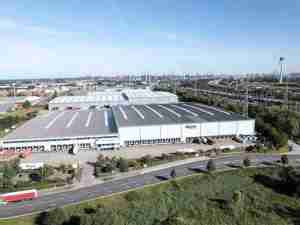APM Terminals Maasvlakte II: As a future operator on Maasvlakte 2, APM Terminals Maasvlakte II (AMPT MVII) is making good progress on its new container terminal. The construction of the terminal is proceeding on schedule with the opening planned for November 2014. The terminal design signifies a step forward in productivity and sustainability. The cut-through of the Yangtzehaven next weekend is important for APMT MVII so that it can receive its first ship with crane parts in the spring of 2013.
With a quay wall depth of 20 metres and the highest deep sea cranes in the world, this terminal will soon be open for the arrival of the latest generation of 18,000-TEU container ships. The first phase of the terminal covers 86 hectares and has a capacity of 2.7 million TEU per year. The terminal can expand to 167 hectares and a capacity of 4.5 million TEU per year.
Rotterdam World Gateway: The construction of Rotterdam World Gateway (RWG), Rotterdam’s new container terminal on Maasvlakte 2, is on schedule. The site on the Amaliahaven is gaining more and more shape now that RWG started on the asphalting in the summer. It is anticipated that the terminal will be opened in the autumn of 2014. The placement of the quay cranes one year before that is an important milestone. Terminal testing will also start around that time, so that by the spring of 2014 the first ship can moor.
The terminal is shooting up on a 108-hectare site and has a deep sea quay of 1150 metres long and 20 metres deep. A 550-metre inland shipping quay has also been constructed. Eleven deep sea cranes and three cranes for inland vessels will be placed on these quays. Together with around 50 stacking cranes and 60 AGVs (automatically guided vehicles that will move the containers around the site), this will ultimately deliver a capacity of 2.35 million TEU.
Railway connection: Both terminals are expected to be the most modern in the world. This will make it possible to handle the next generation of ultra-large container ships in Rotterdam. The new container terminals will each have rail connections which must meet the latest requirements in rail safety. The connections for both terminals are planned to be ready by the end of 2013. This will enable the terminals to be fully set up for the intermodal handling of the cargo – the basis of the modal shift objective of the Port of Rotterdam Authority. This means that as many containers as possible are transported to the hinterland by inland shipping and rail.
Road and rail along the seawall: The Yangtzehaven will be connected to the ports on Maasvlakte 2 next weekend and that is due to the opening of the road and rail along the new seawall. The road and rail were opened on 19 and 28 October respectively, opening up access via Maasvlakte 2 to the businesses of Euromax, MOT and GATE. This made it possible to remove the existing infrastructure on the Yangtzehaven shortly afterwards. In the short time between 11 July (closing of the seawall by Queen Beatrix) and the end of October, the last section of the seawall was raised to the required height and the road and rail were built. The sport beach has also been open since October.
Viaduct Junction E: Construction work at the entrance to the ECT and APMT terminals on Maasvlakte 1 has also commenced. Traffic from and to Euromax has not come past here since October. Traffic to the new APMT terminal on Maasvlakte 2 will









